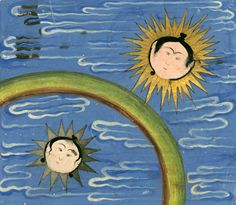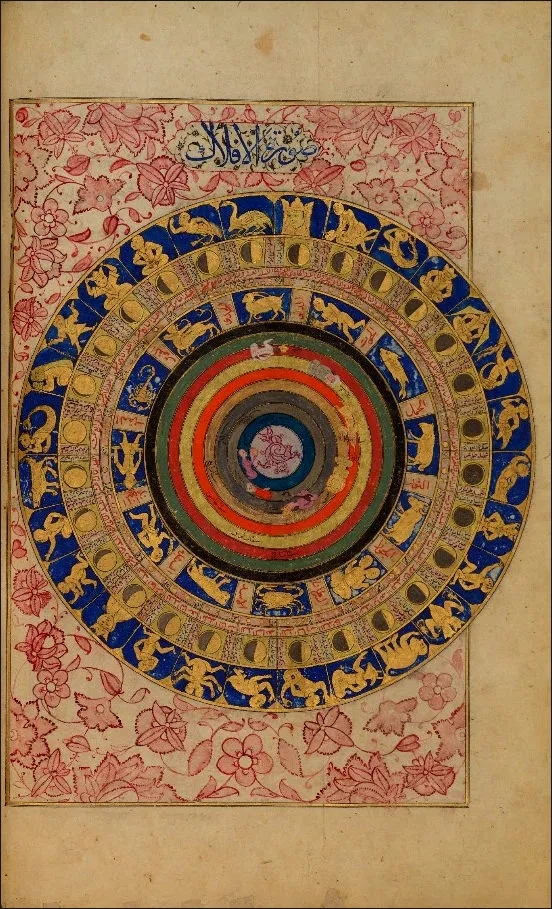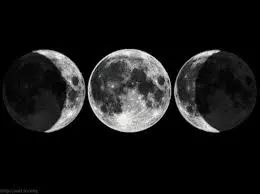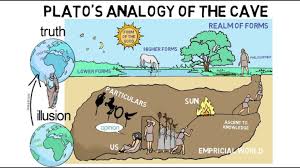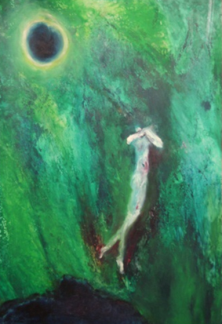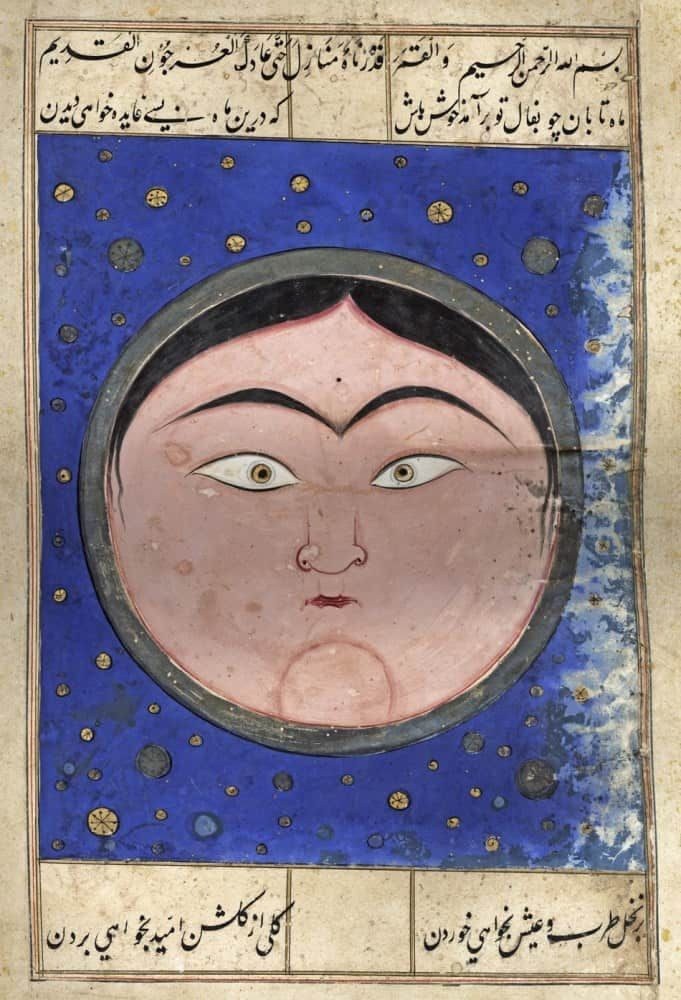
from The Celestial ‘Polished Mirror’ – The Mystical Dimension of the Moon according to
Muhyiddin Ibn ʿArabī – Esmé L.K. Partridge
When the Qurʾan speaks of Allah showing His Signs (āyāt) ‘in the horizons … until it becomes clear that [they are] the truth’ (Q.41:53), its meaning may be construed figuratively. Especially when perceived through the epistemological lens of the ẓāhir and bāṭin – the respective inner and outer dimensions of scripture that are disclosed through esoteric exegesis (taʾwīl) – the imagery of the ‘horizons’ may be interpreted purely as a motif concealing the more abstract, universal truth that is God’s omnipresence. In such an interpretation, the verse’s inner meaning (bāṭin) is perhaps tantamount to others that allude to the boundless presence of God, such as ‘and to Allah belongs the east and the west. So wherever you [might] turn, there is the Face of Allah’ (Q.2:115).
However, for Ibn ʿArabī – the master of distilling the bāṭin from the ẓāhir – the imagery of Allah revealing His Signs ‘in the horizons’ could refer to a more literal, as well as metaphorical, phenomenon: the celestial bodies as Signs of His nature and attributes. Such an interpretation would cohere with his cosmic vision in which the universe, like the Qurʾan Itself, is composed of ‘letters, words, chapters and verses’ that are each Divine self-manifestations (tajallī); the objects that adorn our immediate horizons are no exception. In particular, the Moon – an entity that is perennially invoked in spiritual art and poetry – shines with numinous qualities, presented by Ibn ʿArabī in several of his works such as the Tarjumān al-ashwāq and the Futūḥāt al-Makkiyya:
We say: As for the shining of the full moon that God set up as an image in the cosmos for His self-disclosure through His ruling property within it, that is the divine vicegerent, who becomes manifest within the cosmos through the names and properties of God … in the same way, the sun becomes manifest in the essence of the moon and gives light to the whole of it. Then it is called a full moon. Hence the sun sees itself in the mirror of the full moon’s essence, for it drapes it in a light through which it is called a full moon.( bn ʿArabī, The Meccan Revelations, Vol. II, ed. M. Chodkiewicz, trans. C. Chodkiewicz and D. Gril (New York: Pir Press, 2004)
This striking passage pertains to an elaborate schema of the Moon as a mystical metaphor qua Divine Sign which, although does not appear to have been systematically addressed by Ibn ʿArabī in his extant corpus, can be inferred from various passages of his cosmological, astrological and revelatory treatises. In this schema, the Moon is a representation of Man (and the Sun a representation of God), with the astronomical phenomena of gradual illumination paralleling the process of taṣawwuf.
Just as the Moon traverses from its station in the penumbra of the Earth to an elevated position where it can fully reflect the Sun, the mystic overcomes the shadows of the
world (dunyā) and transforms into an individual gleaming with the splendour of God’s attributes (embodied by the paradigm of the Insān al-Kāmil). The mystic, like the Moon, becomes a ‘polished mirror’, in which the light of God is reflected. Moreover, the Moon and its processes function as analogical Middle Ways that mediate Divine Reality with creaturely nature, inviting a plethora of comparisons with other tenets of Ibn ʿArabī’s mysticism, including his version of the twenty-eight lunar mansions; the twenty-eight spiritual ‘way stations’ (maqāmāt); and the twenty-eight letters of the Arabic alphabet.
The following extrapolates this vivid constellation of metaphors, drawing on Ibn ʿArabī’s theories of cosmology, astrology and prophecy. Before proceeding, however, it may be necessary to note the subjectivity of the approach employed in doing so, on behalf of both the author and the Shaykh himself. Returning to the epistemology of the ẓāhir and bāṭin, it is characteristic for esoteric interpretations of exoteric forms – in this case, the Moon – to be relative to the individual imagination. When speaking of the noetic value of āyāt (signs) in the Futūḥāt, Ibn ʿArabī himself states not only that ‘the function on the [spiritual] journey is to “increase knowledge and open the eye of understanding”, but also that these revelations are “different [for different individuals]”.’
Though the following interpretation is ultimately a personal one and thus subject to the difference of individuality which Ibn ʿArabī speaks of, it nonetheless strives to ‘open the eye of understanding’ for all. In the hope of doing so, the deeply mystical significance of the Moon will now be illuminated, inspiring a reflection on the cosmos and the Signs with which it is embellished.
As a preliminary to the exploration of Ibn ʿArabī’s celestial metaphors, it is vital to familiarise oneself with the dynamics of light as presented within his cosmological writings. Of upmost importance to the mystical dimension of the Moon is the general notion of emanation; that is, the dispersion of Divine Light in a cosmic hierarchy of successive degrees. In this process of emanation, the True Light (or ‘the Light of Lights’, to borrow the jargon of Shihāb al-Dīn Suhrawardī) emanates His light throughout the cosmos, with this light becoming gradually dimmed in accordance with the constitution of the bodies that receive it. The highest and lowest intensities of that light form the duality of brightness (nūr) and darkness (ẓulma) – one of the many binaries spoken of by Ibn ʿArabī in the Futūḥāt – with the latter signifying the furthest departure of the light from its source.
Between the two states of Absolute Light and darkness, however, lies an intermediary, namely, Created Light. Created Light is the projection of God’s light that is cast upon His creations – it neither retains the intensity of the primordial brightness nor extinguishes
the light completely, but is rather an intermediary between the two.
In Ibn ʿArabī’s thought, this notion can be understood in regard to the broader concept of al-barzakh; the ‘isthmuses’ between light and darkness, which exist in varying degrees corresponding to the ontological hierarchy of the marātib al-wujūd; the levels of existence which each participate in differing intensities of the True Light.
Everything in creation participates in an intermediary barzakh, including Angels and human beings who host degrees of Created Light through the aforementioned process. William Chittick has summarised this phenomenon in the context of Ibn ʿArabī’s angelology, in which the Angels host the strongest and brightest degree of radiance from the True Light:
The angels (malāʾika) are – according to the Prophet – created from light, which is to say that their very substance is woven from light. This is not the Light which is God, for God in Himself is infinitely incomparable, even with the greatest of the angels, all of whom are His creatures. So the light out of which the angels have been shaped and formed is the immediate radiance of Light or Being.
It is emphasised here that Created Light is distinct from Divine Light itself; the ‘immediate radiance’ it emits is transferred to subservient bodies through emanation, in the process of which transmuting into its own unique type of light. This can also be understood as a form of projection, whereby the body that is subject to the emanation of the primary source appears to emulate it to some degree; yet, it is not numerically the same light but rather an appearance of it, filtered by the quality of its own constitution.
Even before the celestial bodies themselves are formally introduced, this mechanism can be comfortably applied to the astronomical phenomena acting upon the Moon. Just as the light present in Angels and human beings is not literally the light of God Himself, the light of the Moon is not numerically the same light as that of the Sun. Rather, its luminosity can be attributed to what is known in astronomical jargon as an ‘albedo’; the fraction of light that falls on satellites and other bodies that are non-luminous themselves.
Moreover, the quality of a celestial body’s albedo of Imagination is also dictated by its own constitution; a principle that is of great significance to the comparison of the Moon with the human being, whose reflection of God is subject to his own nature.
The potential to compare the Moon and the human being is consolidated by the Qurʾanic notion that Allah created both of them from the same substance: clay.
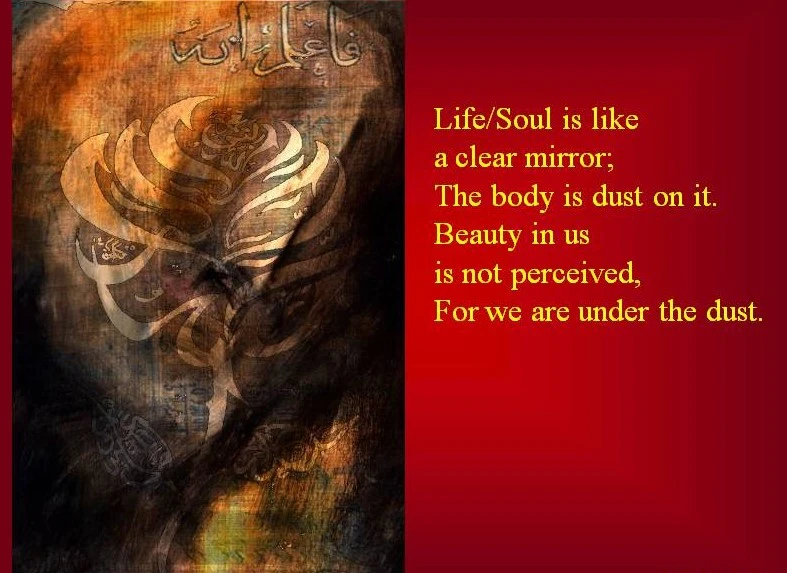
Not only is this striking in being somewhat foretelling of the later discovery that the Moon was formed from the Earth’s debris – thus being of a similar material composition – but also because it offers a firm basis for the conceptual comparison of the two. Being of the same substance, they host Created Light through the same dynamic of projection or reflection. Furthermore, another key commonality is that both entities’ manifestation of the True Light is not static, but subject to variation depending on certain conditions. The Moon undergoes different degrees of illumination from the Sun over its courses of waxing and waning; similarly, the human condition is subject to deviation away from its Divine reflection, with the existence of worldly temptations that can lead one astray from the path towards God. Just as the new moon retreats into the shadows, the mind is susceptible to submersion in the darkness (ẓulma) of the world. In the context of an exegesis of Qurʾan 17:20, Ibn ʿArabī describes this process and how human beings (the ‘loci’) are responsible for the amount of
light that they receive – God’s light is absolutely constant, while the human constitution can fluctuate:
God is saying that He gives constantly, while the loci receive in the
measure of the realities of their preparedness. In the same way, you say
that the sun spreads its rays over the existent things. It is not miserly
with its light toward anything. The loci receive the light in the measure
of their preparedness.
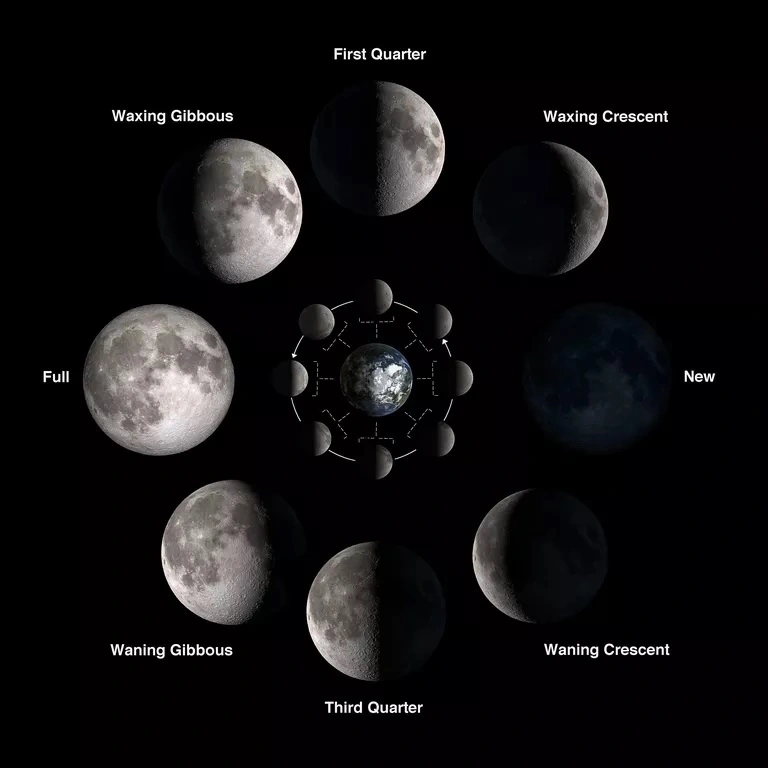
The path of the Sufi is to maximise their ‘preparedness’ through the process of tazkiya (spiritual purification), also known ubiquitously in Islamic mystical literature as ‘polishing the mirror’.
Before proceeding into the nuances of this metaphor in relation to the Moon, the foundations of Ibn ʿArabī’s science of light can be summarised as follows:
- The Moon and the human being are conceptually similar as bodies of ‘Created Light’, which do not exhibit the light of God or the Sun from their own physical nature but through the projection or reflection of its radiance.
- Both are composed of the same ‘clay’, causing them to share similar reflective properties.
- Both are consequently prone to both light and darkness. As barzakhs, they both exhibit varying degrees of Divine radiance. This manifests in the Moon’s perennial waxing and waning, and in the human being’s varying susceptibility to darkness shown in how some hearts can be ‘perfect’ or ‘unique’ (to borrow adjectives used by Ibn ʿArabī himself) and some can be eclipsed by the shadows of materiality. Additionally, particularly during the phase where it is exactly half illuminated, the Moon can also be thought to embody Ibn ʿArabī’s concept of the munāzalāt; the precise mid-point between God and Man where the
descent of God converges with the ascent of the human.
Overall, the Moon can be considered as a medial in several regards; as a host of Created Light, it participates in both light and darkness. Its physical situation as an intermediary in the structure of the cosmos is further elaborated by Ibn ʿArabī in his treatise on astrology – an art which in itself serves as a medium that bridges the celestial with the terrestrial, analogically reconciling the World of the Unseen (ʿālam al-ghayb) with the rubrics of language and geometrically comprehensible structures. Within these structures are the hierarchy of celestial spheres, mentioned previously in the context of Ibn ʿArabī’s marātib al-wujūd, the different degrees of existence. Their representation as concentric circles – depicted in Titus Burckhardt’s translation of Ibn ʿArabī’s astrological manual – reveals their order, from the highest point of the cosmos that is the Divine Throne, to the lowest: the ‘floor’ (farsh) of the Earth. In this diagram, the sphere of the Moon is situated directly above that of
the worldly elements. This indicates the Moon’s status not only as a barzakh in regard to light, but also in regard to space: it is an intermediary between the Earth and the higher degrees of the cosmos, akin to how the human being is suspended between the light of God and the dimmed constitution of its corporeal physicality.
The 9th-century polymath al-Kindī, invoking Aristotelian physics, was the earliest to offer an Islamic perspective on these hierarchical celestial dynamics. He regarded the stars and planets as ‘proximate agents’ for God’s actions, likening this phenomenon to the function that the bow has in an archer’s firing of an arrow.
According to this view, the Moon is a casual mediator in addition to a mediator or light. Notably, the Arabian astrologer Abu Maʿshar – who lived during the same Golden Age as al-Kindī and potentially influenced Ibn ʿArabī’s own astrological framework – commented that the Moon has a heightened impact on the Earth. According to him, it is ‘the swiftest object in the heavens’, meaning it ‘exerts the greatest effect on human affairs’; this is another valuable consideration in the interpretation of the Moon as a midpoint between God and Man in the Islamic cosmic vision. These insights should thus be considered for the present study, offering a more detailed picture of the celestial spheres and their relations to each other.
Furthermore, an essential quality assigned to the Moon in Ibn ʿArabī’s astrology is that of the imagination (al-khayāl), and more conceptually the imaginal realm (ʿālam al-ghayb) – another conceptual point of mediation. In Islamic mystical psychology, the imaginal realm functions as a point of crossover between the sensory world and the Divine, whereby imaginative powers make it possible to conceive a physical, limited object existing in a state
of unlimited permanence or abundance. For instance, an object encountered by the senses a posteriori is subject to the eventual decay of its material form. But, if the same object is imagined, one can conceive its perfect, everlasting form, which is not bound to spatio-temporal limitations. In this sense, the imagination is able to coalesce the realities of the worldly with the possibilities of the Unseen, conceptually hosting both shadow and light. It is
because of this that the imagination can be thought of as an ontological barzakh – another intermediary between the two planes of existence where, as Ibn ʿArabī tells us in his Meccan Revelations, ‘meanings manifest in sensory frames’.
The Moon – exhibiting both a luminous albedo and the darkness of its corporeal ‘clay’ – is
conceptually identical to the imagination in this sense. Not only is the Moon physically in-between the Earth and the higher spheres, but it is also an ‘in-between’ in terms of its ontological status, residing in the imaginal realm between the sensory and Divine realities.
The relationship between the Moon and the imagination is deepened further by their mutual association with Cancer (known in Islamic astrology as al-saraṭān), the fourth zodiac sign which is typically associated with imagination and memory.

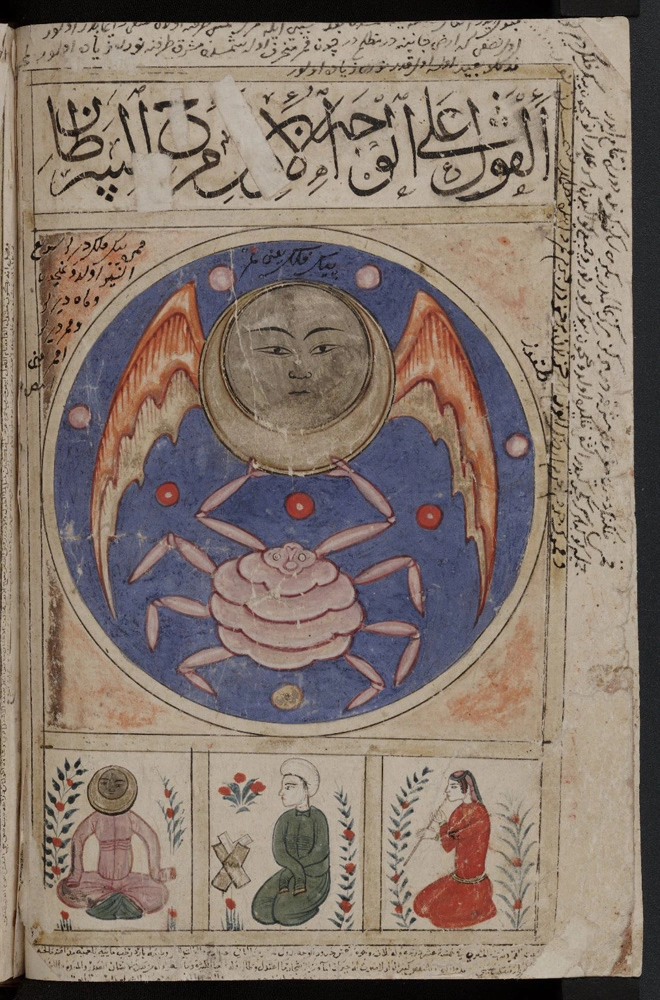
Its connection with the Moon can be found illustrated in the 14th-century Persian mystic Mahmud Shabestari, in his poem The Mystic Rose Garden:
the Moon sees in Cancer a creature akin to herself,
When head becomes tail she assumes the form of a knot
the Moon passes through eight and twenty mansions,
And then she returns opposite to the Sun.
According to Ibn ʿArabī, the zodiac signs themselves are ontologically aligned with the lunar and imaginal realms, existing in a ‘threshold realm’ that is ‘accessible to the human imaginative faculty’. Thus, in this context the Moon, the imagination, and their expression in the sign of Cancer, can be thought to represent the same overarching notion: imaginal intermediaries between the darkness (ẓulma) and mundanity of the dunyā and the brightness (nūr) and transcendence of the True Light.
Of further significance here is that the imagination itself is an analogical intermediary. This is worth noting in the mystical context of considering that the purpose of a figurative device, whether in the territory of literature or, in this case, the cosmos, is to harmonise the unknown (God) with the known (the physical world). This is the ability of the imagination, which as we have established is itself symbolically tied to the Moon. Its constitution enables the perception of Divinity through the corporeal instruments of the senses, translating the ineffable brightness of Him and His attributes into a conceivable reality.
Just as God cannot be grasped without analogy, the Sun cannot be perceived without its light being somehow filtered (at least, not without risking severe retinal damage).
Plato, in his Allegory of The Cave, speaks of how the overwhelming brightness of the Sun will stun the mind of the cave dweller beyond comprehension. He does, however, explain that we can gradually accustom ourselves to ‘the sight of the upper world’ through exposure to its lower intensities. The Moon, in this case, makes this possible through mediation. While
we cannot gaze at the Sun, we can gaze at the Moon – a body which imitates it upon the perceptible canvas of corporeal clay. Here, the Moon once again proves itself to be not only an astrological but also a theological barzakh, embodying, along with the imaginative faculty, functioning as the mystical Middle Way. Thus, the Moon can be thought of as a Middle Way in its epistemological function.
Moreover, the stations that the Moon undergoes in the process of becoming full are, as will now be explored, representative of another kind of Middle Way, namely, the path which human beings must surpass to move from worldly life to a state of unity with God.
A defining quality of the Moon is that its situation is not static; it exhibits different degrees of the Sun’s light over the course of twenty-eight days. What is the significance of this gradual progress towards the perfect reflection? Ibn ʿArabī’s Alchemy of Human Happiness, recently translated by Stephen Hirtenstein, offers a full extrapolation of his spagyric metaphors, providing further insights into the process of spiritual purification, which parallels the
process of illumination undergone by celestial bodies. The transmutation into gold as an analogy of the human being’s attainment of eudaimonia – that is, becoming one with God – is perhaps the most significant of all.
Gold, in the imagination of the ancient world, is a substance conceptually tied to the immortal light of the Sun. Alchemical transmutation represents the purification of a lesser metal (most commonly, copper) into gold, which through a series of chemical reactions comes to resemble its radiance – a process which can be, literally and figuratively, likened to the Moon and its attainment of the Sun’s luminosity upon becoming full. This comparison
becomes even more lucid when we study the two key elixirs in alchemy: the white and the red. The former is explicitly equated to the Moon itself, aiding the transformation of copper into silver, while the latter is compared to the Sun, which then turns silver into gold.
Again, the Moon – or rather, its elixir form – here functions as the point of transition or causal Middle Way between the lowest of materials, such as copper (or clay, our worldly form) and
supreme gold (the True Light). Alchemical purification vis-à-vis eudaimonia – which could also be compared to the Sufi gnosis, that is, fanāʾ (self-annihilation preceding Divine union) – is achieved through a procession of stages, or alchemical reactions as it were. In the Futūḥāt, Ibn ʿArabī refers to these as maqām (plural: maqāmāt) and in other sources ‘the degrees of perfection’ (kamāl) or ‘way stations’ – recurring terms in soteriological Sufi discourse. For instance, Ibn ʿArabī himself cites al-Harawī’s volume on the 100 ‘way stations’ of moral and spiritual development, which are also extrapolated by the Persian saint Khwajā Abdullāh Anṣarī, who describes in more depth the successive stages bridging the transition from self-awareness to self-loss.
Ibn ʿArabī’s framework of spiritual stages, however, designates not 100 degrees, but twenty-eight – a figure with inherent lunar connotations. These twenty-eight degrees can also be associated with the twenty-eight mansions of the Moon (manāzil al-qamar), featured previously in Shabestari’s poem and discussed by Ibn ʿArabī in his treatise on astrology. These ‘mansions’ are a sequence of astrological houses through which the Moon passes during its orbit. Each house is tied to a zodiac sign and can be figuratively compared to the notion of the way stations or maqāmāt through which the Sufi must traverse to reach his final station of spiritual ‘fullness’.
What is particularly paramount in Ibn ʿArabī’s system of astrology is the connection between the twenty-eight lunar mansions (the celestial ‘way stations’) and the twenty-eight characters of the Arabic alphabet. Chapter 2 of the Futūḥāt offers a deeper analysis of the subliminal qualities of the letters, such as Alif, Zāy and Lām, which Ibn ʿArabī describes being orthographically linked to form the root of a verb denoting ‘eternity’. Insights such as
these demonstrate the rich esoteric dimensions of the Arabic writing system, which manifests in other tenets of Islamic belief such as the inherent holiness of the Arabic Qurʾan. Moreover, the Sufi practice of remembrance (dhikr) entails the recital of Allah’s ninety-nine Names in Arabic, which too inspires the mystical experience. Speaking in the Arabic language, a bridge between the human tongue and the Word of God (the Logos), can thus be seen as an inherently mystical act and, furthermore, one that serves as another form of Middle Way. Considering this, it becomes clear why Ibn ʿArabī compares its alphabet with the Sufi’s twenty-eight way stations towards Divine Union; it facilitates the presence of
God, just as the Moon does in its stages of ascension to fullness, both through twenty-eight modes.
Considering all of the above, it is apparent that the principle of ‘polishing the mirror’ can be applied to the phenomena of the Moon and its gradual process of illumination. The concept of spiritual purification that it pertains to ties in not only with Ibn ʿArabī’s metaphors of alchemical transmutation, whereby lower materials transmute into gold, but also with the concept of the Moon becoming the fullest reflection of the Sun. The polished mirror represents the human being who has, by progressing through the moral and spiritual ‘degrees’ or way stations and other noetic intermediaries, come to reflect Divinity; likewise, the Full Moon is the result of its traversion through the astrological lunar mansions, which
too are an intermediary bridge from the shadows of darkness to the reflection of the True Light. Both bodies have undergone a process of becoming ‘polished’, eventually coming to exhibit the highest degree of Created Light. The final phase of this metaphor will now be explored in the context of spiritual revelation and prophecy.

In one Hadith, we find an encounter where al-Barāʾ b. ʿAzib is asked, ‘Was the face of the Prophet (as bright) as a sword?’ He responds, ‘No, but (as bright) as the moon.’ Such is emulated in an account of Jābir Ibn Samura, a Companion of Muhammad, who recalls his face resembling the Full Moon in the night sky. What may appear merely as figures of speech here in fact coincide perfectly with Ibn ʿArabī’s celestial metaphors. The Prophet Muhammad is the embodiment of Allah’s attributes within the human form, and thus represents the perfectly polished mirror that is radiant with the True Light. Nonetheless, Muhammad is not Allah himself; he remains a mortal human of worldly clay, subject to the impermanence of the physical world just as the Moon is subject to perpetually waxing and waning. Ibn ʿArabī alludes to this phenomenon in the Futūḥāt when he speaks of the individual experiencing gnosis as ‘[God] manifest[ing] Himself through your essence in your outer form’; the mystic receives God’s light, but nonetheless retains his worldly nature in regard to his or her physical exterior.
It is not only Muhammad who is symbolically associated with the Moon; in Ibn ʿArabī’s parable of the two travellers in his The Alchemy of Human Happiness, the paradigmal nature of Adam – the primordial Insān al-Kāmil – is also associated with it. The correspondence of Adam and the Moon is realised by the character of the ‘follower’ – the individual who is attuned to the inner meanings of the sights encountered on the spiritual journey – while
the ‘rational thinker’ perceives only the physical form of the celestial body. While the rational mind sees only the Moon, the intuitive mind sees Adam – itself a powerful metaphor of the importance of perceiving the inner dimension (bāṭin) of worldly Signs. The follower’s insights are corroborated by other passages of Ibn ʿArabī’s, in which he explicitly describes Adam as ‘the mirror of Divinity’.
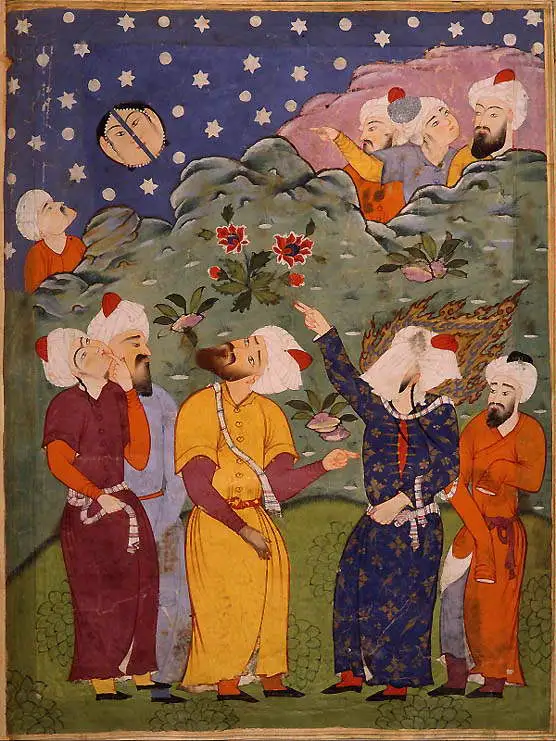
As with Muhammad, Adam is a ‘polished mirror’ who reflects the True Light, as the Full Moon reflects the Sun. Furthermore, the phenomena of Prophecy can be associated with the imaginative abilities, which, as was explored earlier, are qualitatively lunar. Returning to al-Kindī’s 9th-century Qurʾanic science, he speaks of the muṣawwira (imaginative faculty) as the host of Divine knowledge. This is exhibited by everybody to some extent during dreaming (where, according to al-Kindī, sensory recollections from memory coalesce with deeper meaning sent by God), but it is especially potent in those who are receptive to spiritual revelation. This is seen most profoundly in the portrayal of Joseph in Sūrat al-Yūsuf, where his prophetic abilities are revealed through his impeccable dream-interpretation skills. Al-Kindī attributes prophecy to the most well-attuned, ‘polished’ imagination, which can be compared to the fullest illumination of the Moon (which, as discussed previously, is ontologically related to the ʿālam al-mithāl). At this climactic point, the Prophet’s imagination becomes a vessel for attributes of God and, returning to Plato’s allegory of the Cave, marks the moment when the individual: [becomes] able to catch sight of the sun, not just reflected in water, or as it appears in any alien location, but the sun itself, by itself, in its own place, and observe it as it is.
This short excursion has sought to extrapolate on the mystical dimension of the Moon as presented in Ibn ʿArabī’s writings, which can be summarised as follows. In his cosmological system, the Earth’s satellite has the status of a barzakh – an intermediary between Divine Light and mundane physicality. This, as a principle, can be related to the nature of the human condition, which finds itself suspended between the nature of Allah (being created in His image) and that of the physical dunyā. Moreover, it is specifically the imaginative faculty, which, just like the Moon, mediates the two states. The imagination exists in the same ontological ‘sphere’ as the Moon and the zodiac, being suspended between the known
and the unknown.
Moreover, this medial status is significant in the pursuit of mysticism; analogies and symbols fulfil the concept of the analogical Middle Way. The Moon itself is an analogy of Divine Light that has been appropriately dimmed for the inadequacy of human eyes, and on an even deeper level is also itself an analogy for the process of ‘polishing the mirror’ in order to reflect God’s attributes and reach theophanic union. As it was explored, the Moon undergoes twentyeight lunar mansions, which can be compared to the twenty-eight degrees of perfection which can, in turn, be related to Ibn ʿArabī’s metaphors of alchemical transmutation. The Moon also relates to the twenty-eight letters of the Arabic alphabet, which too constitute a mystical Middle Way between worldliness and God, considering
the sanctity of the Arabic language in the Islamic context.
The result of the human being who has undergone these twentyeight stages is a union with God; the Moon’s total reconciliation with the Sun’s light. This can manifest in religious revelation, with prophets (and their imaginative faculties) coming to resemble the
Full Moon. Furthermore, what is symbolically striking in the astronomical phenomena of the Full Moon is the fact that it has, quite literally, risen above the Earth; it is only when the mystic has overcome the dunyā that it can face and reflect the Sun (Allah) in His
totality. This contrasts with the new moon upon which no sunlight can be reflected, symbolising the obstruction of worldly attachment to both material objects and the illusion of the self (nafs).
Meanwhile, the Full Moon – the celestial ‘polished mirror’ – is that which has overcome the obstacle that is the world. It has risen from the shadows of its worldly clay, completed its course of spiritual ascension and, finally, has become illuminated by Allah, the source of the True Light
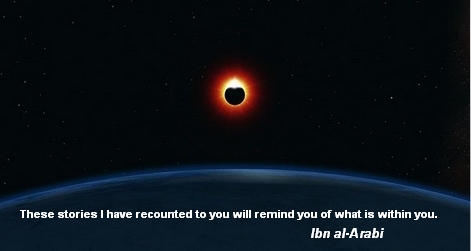
is so that thereby We may strengthen your heart. For through
this there has come to you the Truth and an exhortation,
and a reminder for the believers.” (11:120)
“The prophets are all brothers with the same father.
Their mothers are different, but their religion is one.”
— The Prophet of God
(Bukhari, 4.55.652)
Every Messenger is a prophet, and every prophet is a saint.
— Muhyiddin Ibn al-‘Arabi (the “Greatest Sheikh”)

